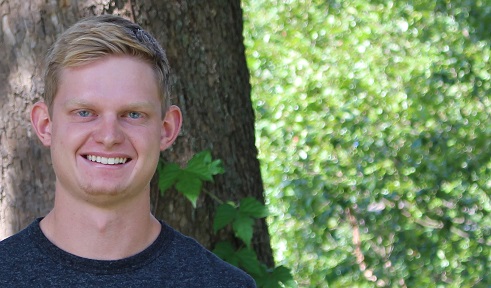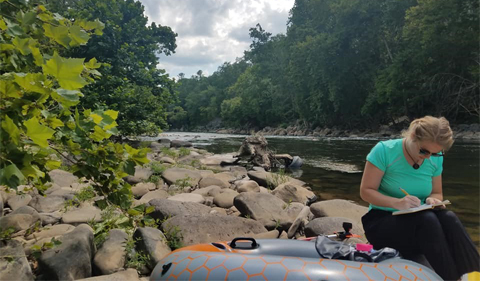
Connor McFadden
The Geological Sciences Colloquium Series presents Connor McFadden and Sara Thurkettle, Geological Sciences graduate students discussing their research on Oct. 12 at 2 p.m. in Clippinger 205.
McFadden presents “Analysis of landscape variability through the Pennsylvanian-Permian Monongahela and Dunkard groups, southeastern Ohio, USA”
Abstract: Paleosols and ichnofossils of the Late Pennsylvanian to Early Permian Monongahela and Dunkard groups of southeast Ohio provide significant paleoenvironmental data related to the Late Paleozoic climatic transition. The purpose of this study was to better understand how increased drying and seasonality of this time affected terrestrial paleolandscapes on a local scale and climatic variability on a regional scale. Twenty-six paleosols from three outcrops in southeastern Ohio were investigated. Methods include the description of paleosol profiles in the field and the analysis of thin sections. Clay mineralogy and bulk geochemistry were used to assess weathering processes and paleoprecipitation. Initial results, such as the distribution, abundance, and size of physical features including slickensides, pedogenic carbonates, and rhizoliths, as well as a transition from gleyed and weakly developed paleosols at the base to oxidized, well-developed, vertic paleosols at the top of the section record responses of the paleosols to alternating mildly seasonal to strongly seasonal conditions with a shift from more seasonally wet to seasonally dry conditions through the study interval. Variability in climate has occurred throughout geologic time having profound effects on paleolandscapes. By investigating changes in paleosols through episodes of climatic transition, we can better understand the impact these changes have on soils and soil ecosystems of the past and future.

Sara Thurkettle
Thurkettle presents “Reconstrucitng Paleofloods in the Bedrock Greenbrier River Using Slackwater Deposits and Hydraulic Modeling”
Abstract: Slackwater deposits and hydraulic modeling will be used to extend the historical record of flood events and determine the critical threshold of erosion in the Greenbrier River of southeastern West Virginia (SE WV). The southward flowing bedrock river incises Paleozoic sandstones, limestones, and shales. The Greenbrier River has experienced three catastrophic floods in the last 33 years: the 1985, 1996, and 2016 floods. The events caused extensive damages in communities alongside the river; the most recent flood destroyed roughly 1,200 homes in the Greenbrier River watershed. This study will better constrain the frequency of floods that have the potential to cause similar damage, which is a matter of urgent need. Also, changes in historic flood frequencies in relation to climate change can be better predicted by studying paleostage indicators (PSIs) from past climate regimes. PSIs can be used as proxies for extending the historical record and reconstructing recurrence intervals of floods. The PSIs are found in nearby caves, but may also include tree scars and surface deposits. Radiocarbon dating will be used to determine ages of pre-historic slackwater deposits (floods) in the caves. Known discharges and recoverable paleostages will be used to calibrate channel roughness in a 1-dimensional modeling program, HEC-RAS. The 100-year flood frequency will be re-evaluated using the back-calculated paleodischarges recovered from modeling pre-historic floods.
Upcoming Colloquia
Abiodun Ayo-Bali of Ohio University Geological Sciences on “Determination of Arsenic and Heavy Metals in the Environmental Phases of Barra de Santiago Marsh Barra de Santiago, El Salvador” and Lucas Howard on “Nutrient Loading from the Maumee River to Lake Erie” on Oct. 19 at 2 p.m. in Clippinger 205.
Ahmadreza Malekpour-Alamdari of Ohio University Geological Sciences on “Spatial and Temporal Variation of Continental Extension in Iran” on Oct. 26 at 2 p.m. in Clippinger 205.
Dawn Ruth of Ohio University Geological Sciences on “Open Questions on Open Vent Volcanoes: Case Studies of Llaima (Chile) and Mayon (Philippines)” on Nov. 30 at 2 p.m. in Clippinger 205.



















Comments